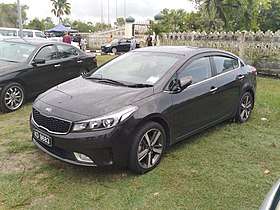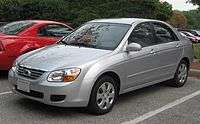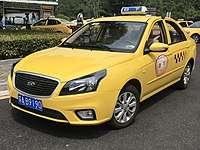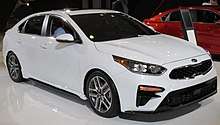Kia Cerato
The Kia Cerato (also known as Kia Spectra in the United States) is a compact car produced by the South Korean manufacturer Kia Motors since 2003. In 2008, the Cerato was replaced by the Kia Forte, however, the "Cerato" name continues to be used in some markets.
| Kia Cerato | |
|---|---|
 | |
| Overview | |
| Manufacturer | Kia Motors |
| Production | 2003-present |
| Body and chassis | |
| Class | Compact car |
| Body style | 5-door hatchback 4-door sedan/saloon |
| Layout | Front-engine, front-wheel-drive |
| Chronology | |
| Predecessor | Kia Sephia |
First generation (LD; 2004)
| First generation (LD) | |
|---|---|
 | |
| Overview | |
| Also called |
|
| Production | 2003–2008 2004–present (China)[1] |
| Model years | 2004–2009 |
| Assembly | South Korea: Hwaseong (Hwaseong Plant) China: Yancheng (Yancheng Plant) (DYK) Malaysia: Gurun (NAM) |
| Body and chassis | |
| Body style | 4-door sedan 5-door hatchback |
| Platform | Hyundai-Kia J3 platform |
| Related | Kia Carens |
| Powertrain | |
| Engine | |
| Transmission | 4-speed automatic 5-speed manual |
| Dimensions | |
| Wheelbase | 2,610 mm (102.8 in) |
| Length | 2003–06 sedan: 4,480 mm (176.4 in) 2006–08 sedans: 4,500 mm (177.2 in) 2003–06 hatchback: 4,341 mm (170.9 in) 2006–09 hatchback: 4,350 mm (171.3 in) |
| Width | 1,735 mm (68.3 in) |
| Height | 1,470 mm (57.9 in) |
| Chronology | |
| Successor | Kia Ceed (hatchback) |
The Kia Cerato was introduced in South Korea in 2003, sharing a platform with the Hyundai Elantra (XD) and using Hyundai's Beta II (G4GC) (CVVT-enabled) four-cylinder engine.
It replaced the Sephia/Mentor sedan and Shuma hatchback.
In North America, the "Spectra" name was used when introduced for the 2004 model year, with "Spectra5" designating the hatchback. For Latin American markets, the Cerato was still named Sephia until 2005, when it was discontinued in favor of the name Spectra. In Europe, the Cerato was replaced by the Kia Cee'd.
For the Malaysian market, the first generation Spectra was launched in Malaysia on August 15, 2007 as the "Spectra5" available only with one trim level and with the hatchback bodystyle powered by a 1.6 litre four cylinder 16 valve DOHC CVVT engine with a 4-speed automatic transmission.[2]
 2004–2006 Kia Spectra5 SX (US)
2004–2006 Kia Spectra5 SX (US) 2003–2006 Kia Cerato LX sedan (Germany)
2003–2006 Kia Cerato LX sedan (Germany)
Facelift
In 2006 a facelift version was introduced, including revised Gamma engines. Stylistically, the bumper and headlamps lost their pronounced crease near the grille area, the trunk lid became more rounded, and the taillights were reshaped.
- 2007-09 Kia Spectra EX sedan (US)
 2007 Kia Spectra5 hatchback (US)
2007 Kia Spectra5 hatchback (US) 2007 Kia Spectra EX sedan (US)
2007 Kia Spectra EX sedan (US)
Kia Cerato R and Horki 300EV
The Kia Cerato R is the extensive facelift of the Kia Cerato to extend sales within the Chinese market, while the second generation Kia Cerato was sold as the Kia Forte in China at the same time. The design was significantly updated to be in line with other newer Kia products. The Horki 300EV is an compact electric sedan with the design being essentially a rebadged version of the Kia Cerato R from the Chinese market, it was unveiled on the 2016 Guangzhou Auto. The platform is the same as the first generation Kia Cerato, which is still in production in China as the Cerato R. [3] [4]
 Kia Cerato R taxi (CN)
Kia Cerato R taxi (CN) Kia Cerato R taxi (CN)
Kia Cerato R taxi (CN) Horki 300E (CN)
Horki 300E (CN)
Second generation (TD; 2009)
_Si_hatchback_(2015-06-03)_01.jpg)
The second generation Kia Cerato was launched in South Korea in late 2008 under the Kia Forte name – a name that was used in most international markets. The "Cerato" name has been retained in some markets, such as Australia, Iran, South Africa and Brazil. In Singapore, the second generation model is badged "Kia Cerato Forte".[5]
At the Sydney Motor Show, held from 9 to 19 October 2008, Kia introduced a new version of the Cerato sedan, which in Europe and North America was called Kia Forte. In the CIS countries, the second generation Cerato retained its name, and its sales began in March 2009. The changes affected the elements of the interior and suspension. The car received a wider (4 cm) and longer (3 cm) body, a longer (4 cm) wheelbase and a wider (7 cm) gauge. However, ground clearance was reduced by a centimeter, thereby reducing the height by a centimeter. At the same time, the design of the rear suspension was simplified, which instead of independent multilink thrust became semi-dependent double-lever, with an elastic beam, which made it more reliable and easy to repair and maintain
Third generation (YD; 2013)
_S_hatchback_(2015-07-16)_01.jpg)
In July 2012, Kia unveiled the next-generation Cerato as the Korean-market Kia K3.[6] The sedan is sold in the United States as the Forte. A coupe and five-door hatchback were released later on.
The new Cerato is produced in South Korea at Kia's Hwasung Plant and in Mexico at Kia's Pesquería Plant.
Fourth generation (BD; 2019)

On January 15, 2018 at the 2018 North American International Auto Show in Detroit, Michigan, Kia unveiled the third generation Forte sedan. Taking styling cues from the Kia Stinger, the new Forte adopts a cab rearward exterior, resulting in a fastback profile and a short trunklid. The car is constructed with 54% advanced high-strength steel that is stronger than the outgoing model. The Forte will be offered with a 2.0L I4 carried over from the second generation model mated to either a six-speed manual transmission or Kia's first CVT.[7]
The Kia Forte is available in three trim levels: base LX, mid-level S, and top-level EX, and went on sale in the fall of 2018 as a 2019 model year vehicle.
References
| Wikimedia Commons has media related to Kia Cerato. |
- "Cerato". DYK. Retrieved 2017-04-14.
- 3370336 (2007-08-22). "Naza Kia Launches All-New Kia Optima and new-look Spectra - Autoworld.com.my". Autoworld.com.my. Retrieved 2018-05-06.CS1 maint: numeric names: authors list (link)
- "The Dongfeng-Yueda-Kia Horki 300EV Is Finally Ready For China".
- "Spy Shots: Horki 300E EV Sedan Is Ready For China".
- "Kia launches the new Cerato Forte". iCars Singapore. 2009-01-31. Archived from the original on 2011-10-06. Retrieved 2010-10-30.
- "2014 Kia Forte Unveiled, Heading to America Early Next Year". AutoGuide.com. 2012-07-29. Retrieved 2012-09-08.
- Ogbac, Stefan (2018-01-15). "2019 Kia Forte First Look: More Stylish and Efficient Compact Now Offers a CVT". Motor Trend. Retrieved 2018-01-16.
